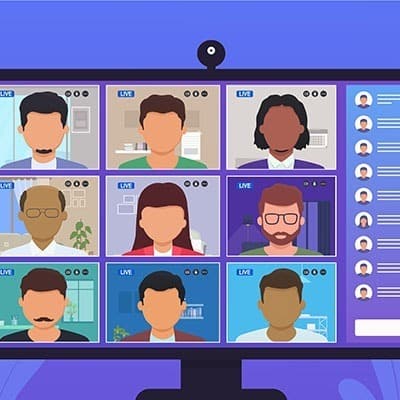Would you believe it if we told you that the members of Generation X, Millennials, and Generation Z are more likely to fall for online shopping scams than those aged 60 or over? Well, according to the Federal Trade Commission, the numbers aren’t even close. If you’re under age 60, you’re 86 percent more likely to fall prey to scammers.
We don’t often talk about mobile malware, but that doesn’t make it any less scary! An Android banking malware called Sova has once again been making the rounds, this time complete with additional features that make it scarier than the last time. What can you do to protect yourself from this threat?
One of the biggest pain points that companies have to consider for remote workers is how productive they are actually being with their time. To solve this dilemma, some employers are opting to use the webcams installed on their employees’ devices to keep tabs on them. While we understand the idea of monitoring your team, perhaps using the webcam to spy on them is not the best way to approach this concept.
Shadow IT—while it sounds like the title of some B-movie suspense thriller or airport gift shop novel, it’s a very serious business issue that can easily make its way into your operations. Let’s review what shadow IT is, and what can be done to minimize the threats that it causes your business.
Remote work might be a somewhat new concept for some organizations, but it has proven to be an exceptionally helpful tool to have at one’s disposal. All that said, however, there are certain weaknesses that must be addressed if you want to take full advantage of the cloud, with one of them being the disconnection that comes from remote work. What does this disconnect mean for your business?
Improved Productivity Not trusting your staff leads to hindered progress in your business, holding back how much you can accomplish. Neither you nor your team can be as productive as possible with you overseeing every detail of their work, as your micromanagement discourages initiative and motivation. Meanwhile, your other responsibilities are left neglected. Do your best to quash any urge you have to monitor your staff so closely, and your collective productivity will increase. Increased Communications The more you trust your team, and they you, the better the transfer of information will be between you. Feedback in both directions will be more honest, as you will be able to level with your team. Likewise, they will feel free to share their insights and potential issues they have identified. Either way, overall productivity can be improved through adjustments from all involved. Inspired Team Members One of the surest signs that an employee can receive that their work is appreciated is to allow them to do their jobs unimpeded–without excessive oversight or interference from the boss–and celebrate their accomplishments after the fact. This kind of trust generates a sense of responsibility for the employee to perform, and positive reinforcement to encourage their self-startership and initiative. Why would anyone want to leave this environment? Doing this can help minimize turnover and benefit your growth. What We Have to Do with Any of This Regardless of how energized and motivated your team is, there is only so much that can be accomplished with less-than-sufficient tools. SRS Networks can provide the solutions to both assist you in building mutual trust with your team, and to help you make the most of these improvements from an operational standpoint. To learn more about how we can help, give us a call at (831) 758-3636.
Here are three variables you should consider when deploying a remote workforce. Employee-Owned Devices Deploying employee devices to meet your business demands is a risky proposition unless you have the right security measures in place. You will want to give your employees the technology that will give them the best chance to succeed; and, won’t cause any unnecessary problems for your data and network security. This is largely because of the way people utilize their personal PCs. On a workstation, people are told which software to use and stick to those titles, but on a person’s personal PC they have all types of software that your network administrator is unfamiliar with. This software, on a personal PC may not be updated and patched, leaving open vulnerabilities that could, very easily become major problems for your company. Since most people that work from home are using a personal device, you need a way to protect your company’s assets from the quagmire some personal PCs present. One way is to provide remote access software. This will allow users to actually remote into their workstation at work and use the resources like they would if they were sitting at their desks. The one problem with remote software is that it is often targeted by cybercriminals. You will want to ramp up network security and demand authentication procedures be enhanced when allowing computers to access business resources remotely. Insecure Connections In the same vein, when working remotely, some employees will be using shared networks. This can cause your IT administrator a lot of headaches. Most users haven’t set up network and cybersecurity resources that are as comprehensive as the ones that the business has. For this reason your employees’ networks are typically much less secure. Even the networking hardware that they use, often people’s only line of defense, is lacking as the software that runs on it isnt always updated. User Behaviors Probably most importantly here is the user. At home, on their home PC, they are much more likely to do things that they would never think of doing on their workstation in the office. Adding to that, without the constant security reminders they get at work, they are less apt to follow best practices as their workplace enters their homespace. You need to ensure that you make the point that just because they are working at home doesn’t mean that any of the practices that they’ve been drilled on can be ignored. Remind them the dangers of phishing attacks and how it is even more important to be vigilant about what they click on. The last thing we need to talk about is employee misconduct. Some employees, if given a foot, will take a mile. It is important to monitor your employee’s productivity well enough to ensure that they are doing their work, and that the work is in line with what you expect from that position. Some people won’t take to it as well as others, but by-in-large, workers that work remotely work with an ease that allows the work to be better and for productivity to not dip so much as it will cost your business. SRS Networks knows it’s a difficult time for California businesses. We’re here to help. Call us today at (831) 758-3636 to talk to one […]
Here, we’ll review the benefits that using PowerPoint can bring, as well as what you will want to include in the training materials you create. Why PowerPoint for Training Purposes? PowerPoint is an effective training tool for a variety of reasons – not the least of which is that it is effectively a multimedia platform. Allowing you to present information both visibly and via spoken word, PowerPoint gives you a platform to really reinforce the lessons you want to impart. Now, while there are many tools that PowerPoint includes to assist users in presenting whatever materials they have more effectively, we’re going to focus on one particular web-based feature: Presenter Coach. Presenter Coach does more or less what it sounds like it would do: it allows a user to practice their presentation, catching them as they fall back on undesirable public-speaking habits. The official video from the Microsoft Office 365 YouTube account explains it best: So, in a way, PowerPoint can not only help you train your users… it can help you improve your own abilities to train others. To activate it, open up the presentation in PowerPoint for the web. On the Slide Show tab, click Rehearse with Coach. (This option is also under the View tab for some users). What to Include in Your Training Of course, regardless of how well you present it, your training is only as effective as the content that goes into it. As you are creating your materials, it is important that you do so in an organized fashion. Here are a few tips to help you get started. Identify the need that this training should address. In other words, what do you want to teach your team about? What should they know how to do better than before they participated? Keeping this need in mind will help you to keep your training concise and targeted, making it more effective at communicating your specific lesson. Determine what information to include based on the lesson and who you are speaking to. If your training only applies to a given department in your business, use specifics in your presentation to better illustrate your points and drive the message home. However, if the training applies to everyone – as cybersecurity lessons do – make sure you discuss the topic in basic terms that everyone can grasp and put into action. Include visuals, calls for questions, and individual sections to ensure that each topic is understood. Incorporating visual aids and separating your points into their own distinct slides can make the information you are trying to get across clearer to your audience. You should also encourage your team to ask questions throughout the training, and remind them that they can always ask these questions if they are ever unsure. You training doesn’t stop once your presentation is over. You could have designed the best presentation of your life, but if nothing has changed after you deliver it, you need to go back to the drawing board. Be sure that your staff knows that they can give you honest feedback without any backlash from you. Give these tips a try, and feel free to reach out to SRS Networks for more assistance with your productivity tools.








